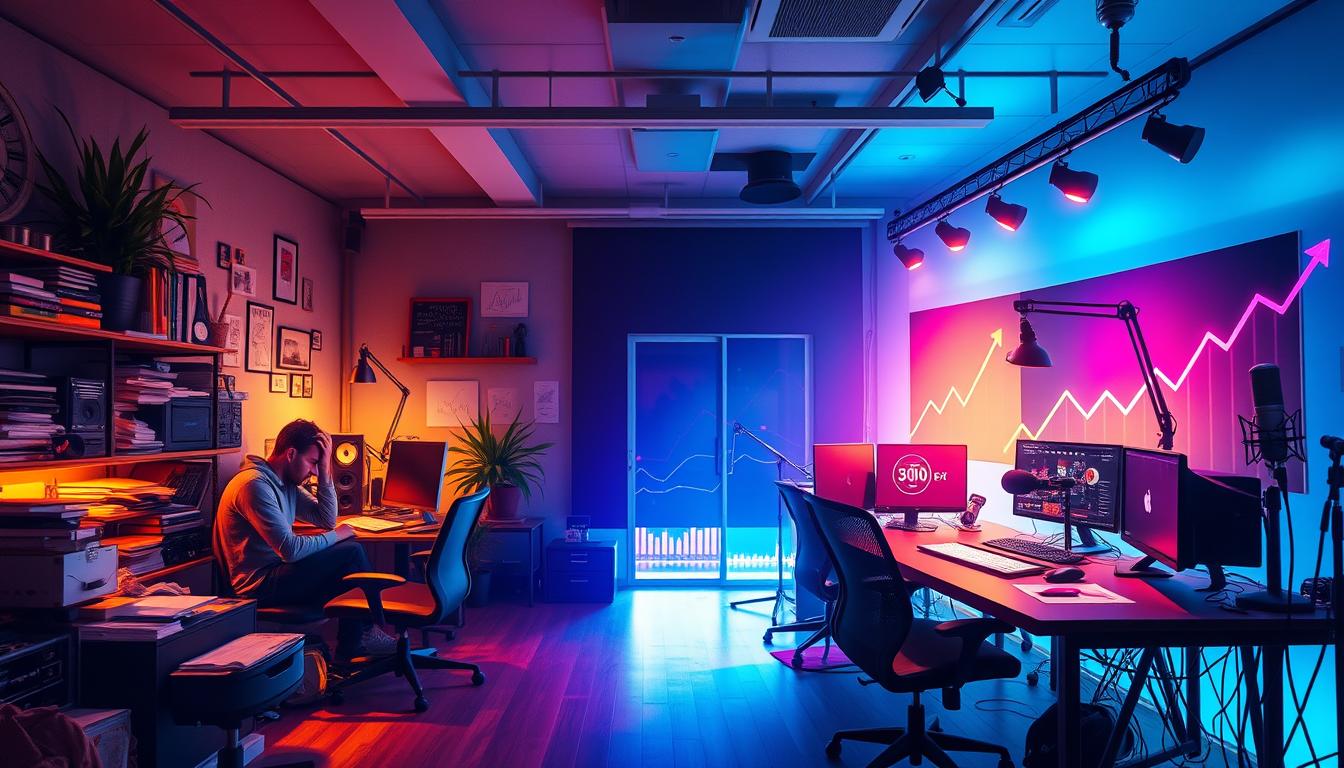Have you ever stopped to listen, totally caught up in a host’s story? If yes, you’re not alone. Millions enjoy podcasts together, and now there’s something new on the horizon. Video content is joining the podcast world. This means you could be sitting back, watching stories unfold on screen. This change will make our favorite podcasts even more engaging. It’s also a big step for the future of how we listen to them. Video podcasts are set to bring new opportunities for listeners and advertisers alike. They’re changing the game in podcast advertising by adding visuals to the mix.
Key Takeaways
- The rise of video podcasting is reshaping listener engagement.
- Authenticity in podcast advertising builds a stronger connection with audiences.
- Podcast listeners are highly responsive to host-read ads.
- Millennials and Gen Z seek podcasts for relaxation and escapism.
- The integration of video content offers brands unprecedented opportunities.
The Rise of Podcasting: A Digital Revolution
The term “podcasting” emerged in 2004. Since then, it has sparked a digital revolution, altering the way we distribute and consume audio content. Billions of people now tune into podcasts for learning and fun. This shows the massive impact podcasts have had globally.
More and more people are listening to podcasts. Surveys show a big chunk of folks have heard at least one podcast. There’s a podcast out there for everyone. You can find shows on all sorts of topics and stories that draw listeners in.
Podcasts are especially great for learning. They fit various styles of learning, making knowledge accessible anywhere, anytime. Listening to these can help listeners grasp concepts better.
Creating podcasts doesn’t cost a lot. This makes them a good choice for teachers wanting to offer cheap learning tools. Podcasts can also create a community of listeners. This shared experience can contribute to everyone’s growth.
The number of search results for “podcast” jumped drastically from 6,000 in 2004 to 1.9 billion in 2021. These numbers show how much interest in podcasts has increased. They highlight podcasts’ growing importance in our digital era.
As podcasts evolve, keeping up with digital audio trends is key. Creators and listeners must stay adaptable and innovative. This will ensure that the world of podcasts keeps expanding. It’s an opportunity to engage more listeners and explore new frontiers in digital audio.
Understanding the Impact of Serial on Podcasting
The Serial podcast influence was a game-changer in the podcasting scene, especially for true crime stories. It started in 2014 and quickly grabbed the attention of many. Interestingly, about a quarter of its audience were first-time podcast listeners. Almost half of these new listeners tuned in every week. This shows how “Serial” was able to bring more people to enjoy podcasts.

“Serial” did more than just captivate its listeners. It also showcased the power of podcast advertising through partnerships with brands like Mailchimp and Casper. These collaborations proved that ads read by the host can really draw in a crowd. This new way of advertising encouraged big names like The New York Times to dive into podcasting. They saw the value of storytelling through audio.
Since “Serial” came out, we’ve seen a change in the kinds of shows available. There’s something for everyone now, from mainstream hits to niche topics. Independent creators are taking the chance to reach specific groups of listeners. Podcasts have become a vast sea of content, offering more than traditional radio ever could.
“Serial” has made a big splash in the world of podcasts. It brought in new listeners and fresh ways to advertise. Its influence is still felt today, making the podcasting scene a rich place full of different voices and tales.
Exploring the Expanding Audience of Podcast Listeners
More people from different ages are tuning into podcasts. Gen Z, in particular, is diving deep into podcasts for focused listening. Around 150 million Americans now listen to podcasts, spending an average of 54 minutes daily. This trend is changing how various age groups consume media.
About 79% of Americans know what “podcasting” means. This awareness is making more people check out podcasts. Young listeners, aged 12-34, feel a strong bond with podcast hosts. They find these connections more meaningful than those with traditional media personalities.
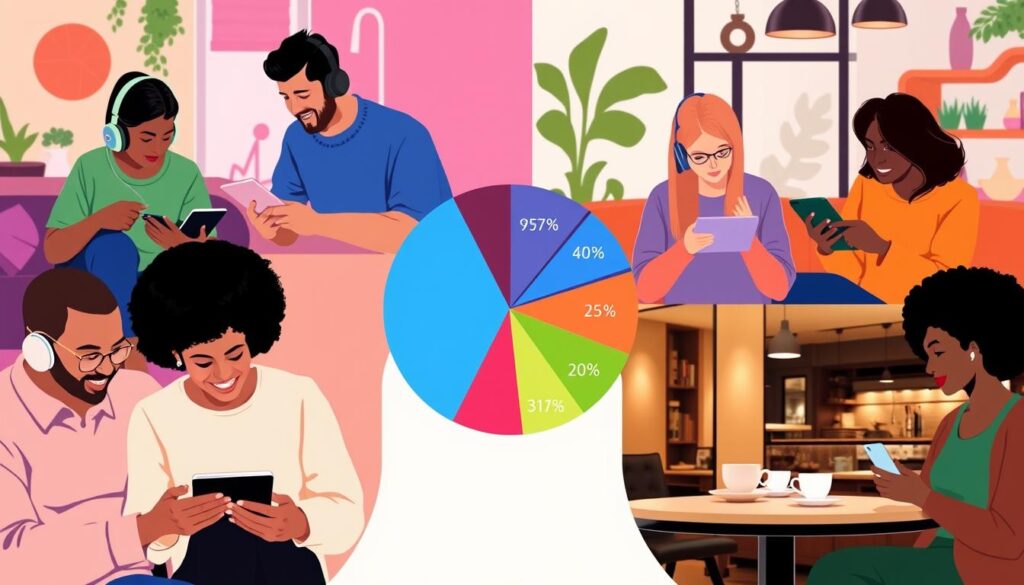
With newer options emerging, podcasts are becoming the go-to choice for many. Reports show that 177 million Americans have given podcasts a try. Listeners are moving from listening at home to tuning in while driving. This is thanks to better technology making podcasts more accessible.
The audience for podcasts now includes a wide variety of races and ethnicities, just like America itself. With these diverse groups showing different listening habits, there’s a big chance for marketers and creators. They can reach out to listeners in more personalized ways.
How This Digital Media Trend Could Change Podcasting FOREVER!
Video podcasting is changing digital media in a big way. It’s making new connections between creators and audiences. With platforms like Spotify and YouTube, creators can mix visuals with audio. Now, about 41% of people in the US have listened to a podcast. More of them like videos too.
The Role of Video Podcasting in Today’s Landscape
Podcast platform strategies are crucial in today’s changing podcast world. Video podcasting lets creators interact in fresh ways. Radio legacy media has a chance to use its resources for video podcasts. This approach reaches young people better on platforms like Spotify and Apple Podcasts.
There are over two million podcasts on various topics. Mixing traditional podcasts with video opens new money-making chances. This means advertising, brand growth, subscriptions, and partnerships can improve. Video podcasts lead to more fan involvement. They help creators keep their audience interested in new ways that sound alone can’t.
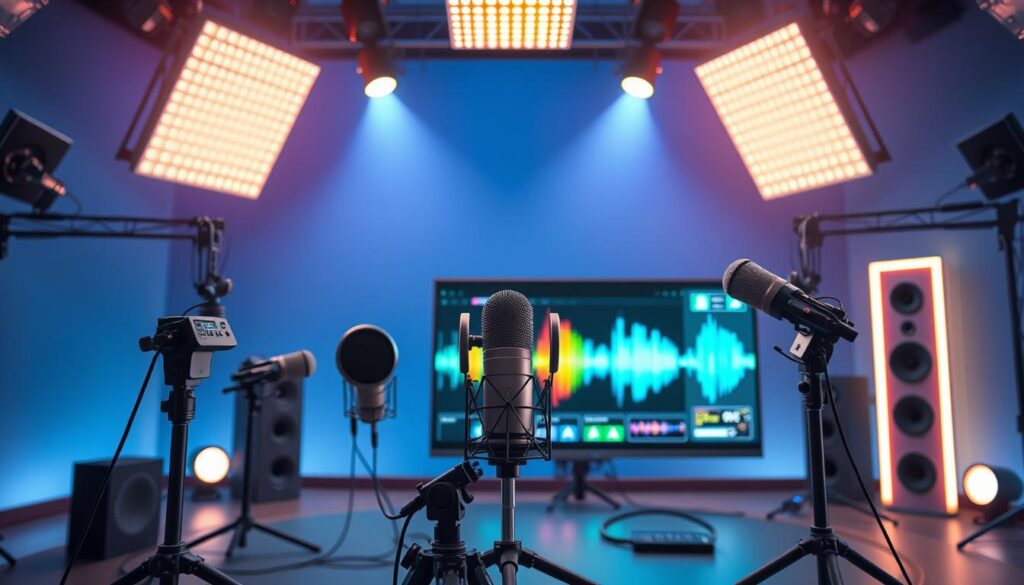
Authenticity: The Key to Successful Podcast Advertising
Authenticity is crucial in podcast advertising. Listeners form a bond with their favorite hosts, creating trust. This trust makes ads more effective, as brands connect with audiences on a deeper level.
About 90% of listeners have acted on podcast ads. This shows how powerful podcasts are in reaching people. Young people, especially those aged 18-34, are very open to podcasts and ads that engage them. Brands can reach these active listeners with the right ad strategies.
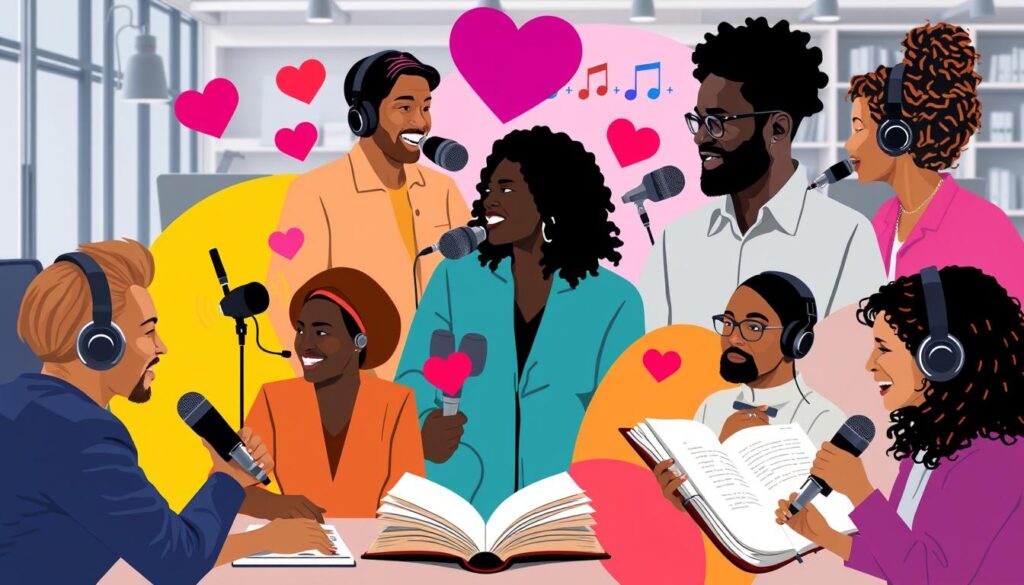
Authentic branding leads to genuine listener engagement. When a host talks about their own experiences with a product, it often results in more sales. This shows the power of storytelling in podcast ads.
- Podcast listeners value realness in ad content.
- Connecting emotionally through ads helps people remember products better.
- Genuine interactions lead to more loyal fans and more sales.
Podcasts are great at keeping listeners’ attention. This makes them an excellent choice for advertisers who want to build strong connections with their audience. As podcasts get more popular, being authentic in advertising is key for brands to succeed.
The Variety of Ad Formats in Podcasting
Podcasting is now a key platform with many types of ads. It meets various marketing needs. Different ad formats work in unique ways, giving brands chances to connect with people.
The Effectiveness of Host-Read Ads
Host-read ads build on the trust between the host and their listeners. This boosts listener engagement and ad recall. Over 85% of podcast listeners prefer ads from hosts they trust. Ads that feel authentic and real perform better.
Because podcasts are intimate, these ads truly speak to listeners. They are a favorite for brands wanting real audience connections.
Utilizing Announcer-Read Ads for Greater Reach
Announcer-read ads, on the other hand, offer wide coverage while staying professional. They’re perfect for brands wanting to extend their reach. These ads deliver messages clearly to all listeners. By using both host and announcer ads, companies can effectively reach different groups of people.
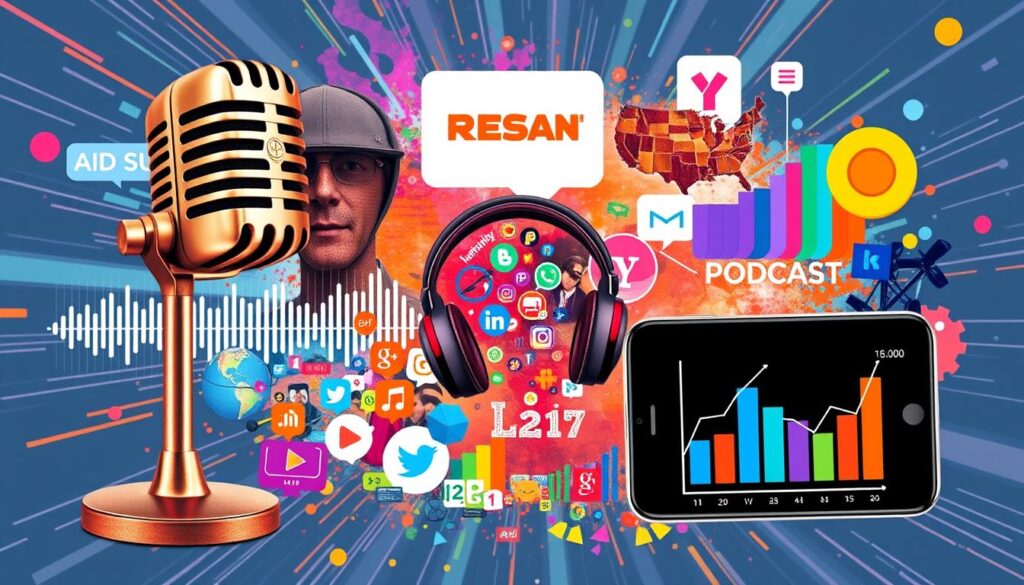
Engaging Younger Audiences Through Podcasts
Content creators see the value in reaching younger listeners via podcasts. They know this medium is growing fast. Each year, 6% more people subscribe. This growth is huge among 12 to 24-year-olds, increasing by 33%. Now, nearly 40% of people aged 12-34 listen to podcasts every week. This shows a big chance to impact the youth through podcasting.
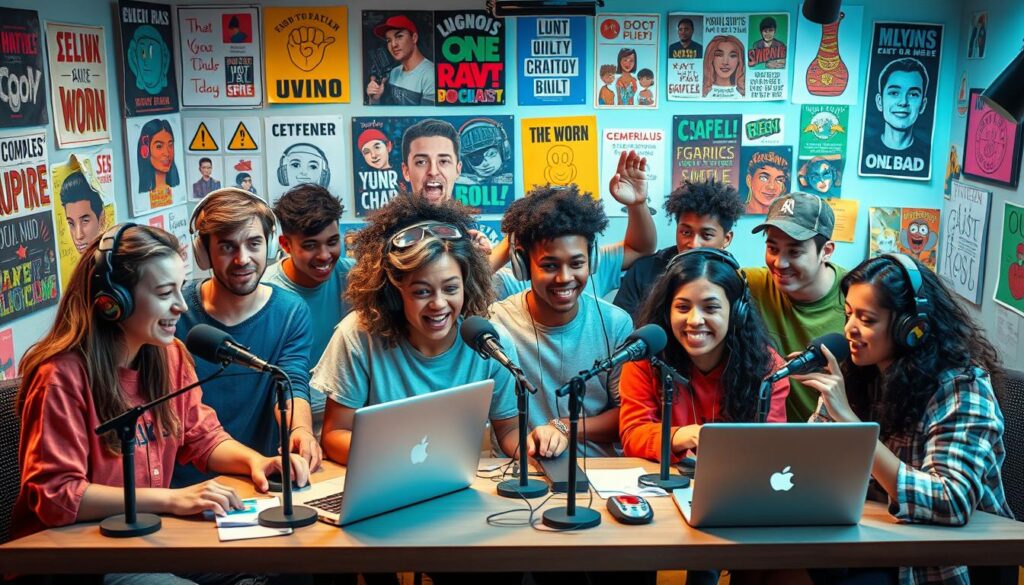
Young people like content that feels real and matches their life and likes. Gen Z, in particular, enjoys podcasts more than standard social media. They find these audio spaces allow for deeper talks and stories they can relate to.
To win over millennials and Gen Z, podcasts should talk about things they care about. Adding humor and keeping it real will help hold their interest. These listeners spend around seven hours a week with their top podcasts. This shows they’re not just passing by; they really get into the content.
| Age Group | Podcast Listening Rate | Weekly Engagement Hours |
|---|---|---|
| 12-24 | 40% | 7 hours |
| 25-34 | 38% | 6.5 hours |
| 35-44 | 31% | 5 hours |
| 45+ | 25% | 4 hours |
By engaging millennials properly, creators can connect deeply with the younger crowd. They must stay ahead as podcast content keeps evolving. This will make the podcast world richer and more enjoyable for all listeners.
Podcasts as a Source of Revenue for Creators
Podcasts offer big chances for creators to make money with podcast monetization strategies. The industry has grown 47% in five years. This shows how creators can explore different revenue models for podcasts.
In the U.S., about 135 million people listen to podcasts monthly. This large audience helps generate advertising income. The IAB U.S. Podcast Advertising Revenue Study says podcast ad revenue might hit $4 billion. This shows the medium’s growing popularity.
Successful podcasts make money from ads, including direct response and brand recognition ads. Subscription models are also key for earnings. Creators offer premium subscriptions for exclusive content. This lets fans get special episodes or behind-the-scenes looks.
Creating strong content is key for keeping listeners and making money. Two-thirds of podcast fans listen to several episodes at once. Quality content keeps listeners coming back. This leads to more revenue.
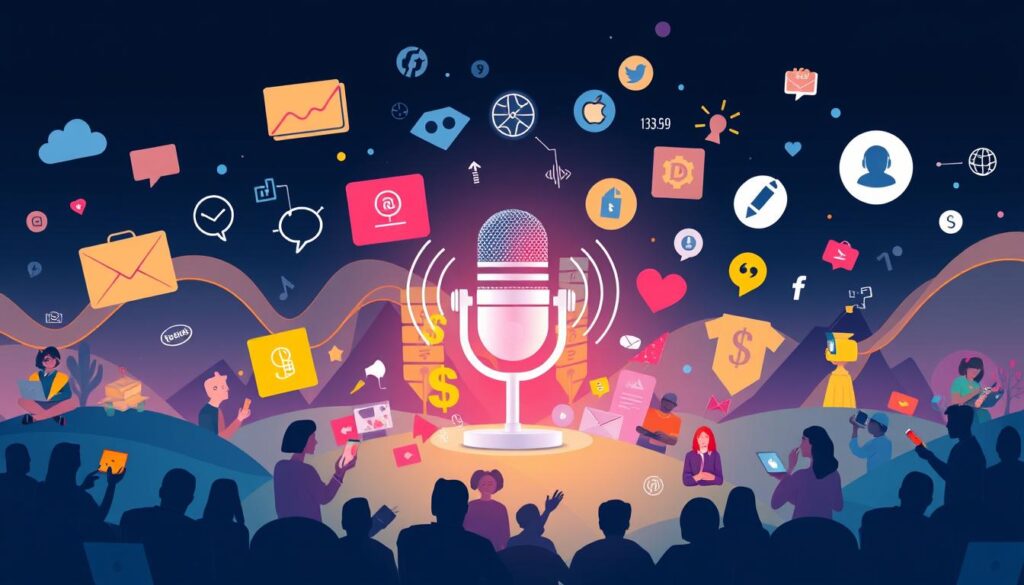
Understanding revenue models for podcasts is useful, especially when budgets are tight. Attracting advertisers can be tough due to strict metrics. However, getting listener feedback is crucial. Most listeners like it when hosts ask for their opinions. This creates a loyal, involved community. Gen Z listeners want to connect through social media. This offers a chance to strengthen relationships and maybe get more subscribers.
There are over 3 million active podcasts, each with its own chance to make money. Creators using these podcast monetization strategies can succeed despite market challenges. They can also grow their projects sustainably.
The Potential of Podcasts for Journalistic Innovation
Podcasts are changing journalism by adding depth and creativity to news stories. They let journalists cover complex topics in engaging ways. This medium is bringing new voices into the spotlight.
There’s a rise in Spanish-language podcasts, especially in Latin America. This growth shows podcasts are great for sharing different stories. Thirteen media platforms in eight countries are using podcasts in new ways.
Outlets are finding new ways to make money with podcasts. They use ads, sponsored content, and consulting. This shows that creative journalism can be profitable.
Below is a table summarizing growth trends in the podcast sector:
| Metric | Statistic |
|---|---|
| Smartphone Users | Nearly 4 billion active mobile users worldwide |
| Monthly News Podcast Listeners | Over one-third of respondents |
| Popularity Among Younger Audiences | Especially strong engagement among listeners under 35 |
| Adoption by Legacy Media | Increasing integration of podcasts into traditional platforms |
| Digital-Native Outlets | Focus primarily on podcasts for content delivery |
Podcasts are becoming more important in news. They meet changing viewer needs and habits. This change is a key moment for the news media industry.

Conclusion
The podcasting world is changing, reflecting wider trends in digital media. These changes affect not just listening habits but also how content is made. The rise of video content and new advertising methods marks a new chapter. This shows the medium’s ability to adapt and grow. Being flexible with these podcasting changes is crucial for creators and brands looking to thrive.
Looking at podcasting’s path, it’s clear that changing listener demographics and more discerning audiences matter a lot. These shifts bring both challenges and opportunities. They can lead to better quality and less criticism through careful content creation. Adaptation is key, not just for now but for the podcasting world’s future health in a varied and tough market.
To stay relevant in the fast-moving digital world, understanding podcasting’s flow is vital. With more people tuning in and exploring different styles, the chance to innovate is huge. Keeping an open mind as we move forward guarantees a place in the energetic podcast community.


